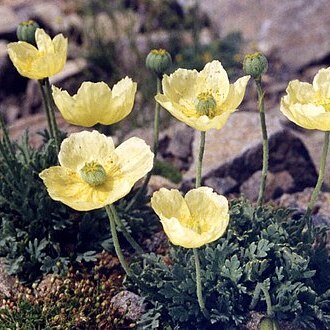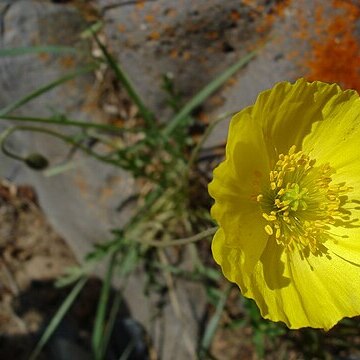Herbs, perennial, 20-60 cm tall, very variable. Taproot terete, extended, upper part 2-5 mm in diam., attenuate or fusiform toward base; rootstock short, thickened, usually simple. Stems very short or apparently absent. Leaves tufted, all basal; petiole (1-)5-12 cm, basally ampliate to sheath, inclined-setose; blade slightly glaucous on both surfaces, ovate to lanceolate, 3-8 cm, both surfaces densely or sparsely gray setose, rarely nearly glabrous, pinnatilobate, pinnatipartite, or pinnatisect; lobes 2-4 pairs, entire or pinnatilobate or pinnatipartite again; lobules narrowly ovate, narrowly lanceolate, or oblong, apex acute, obtuse, or rounded. Scapes 1 to several, erect, terete, densely or sparsely inclined compressed-setose. Flowers solitary, terminal, scapose, cup-shaped, 4-6 cm in diam. Flower buds usually nutant, broadly ovoid to globose, 1.5-2 cm, densely brown setose. Sepals 2, caducous, corymbiform-elliptic. Petals 4, yellowish, yellow, or orange, rarely red, broadly cuneate or obovate, (1.5-)2-3 cm, basally shortly clawed, margin undulate-crenate. Stamens many; filaments yellow or olivine, subulate, 6-10 mm; anthers yellow-white, yellow, or rarely reddish, oblong, 1-2 mm. Ovary obovoid to narrowly obovoid, 5-10 mm, densely appressed setose; stigmas 4-8, actinomorphic. Capsule narrowly obovoid, obovoid, or obovoid-oblong, 1-1.7 cm, densely appressed whitish-or red-brown setose, slightly broadly 4-8-costate; stigma disk flat, distantly incised-crenate. Seeds many, brown, almost reniform, small, striate with alveolate foveolae. Fl. May-Sep. 2n = 14, 28*, 42.
More
A perennial plant which grows 30-45 cm tall. It spreads to 25 cm across. It is best treated as a biennial plant. The leaves form rings or rosettes at the base. The leaves are 3-15 cm long. These are hairy and deeply divided. They are grey-green. The stems are long and slender and leafless. The buds at the top are plump, hairy and nodding. They open to bowl shaped flowers with four petals. They are 5-10 cm wide. The flowers have a slight scent. The flowers can be white, pink, orange or yellow.
Subspecies numerous (1 in the flora): boreal North America, Europe, Asia.


